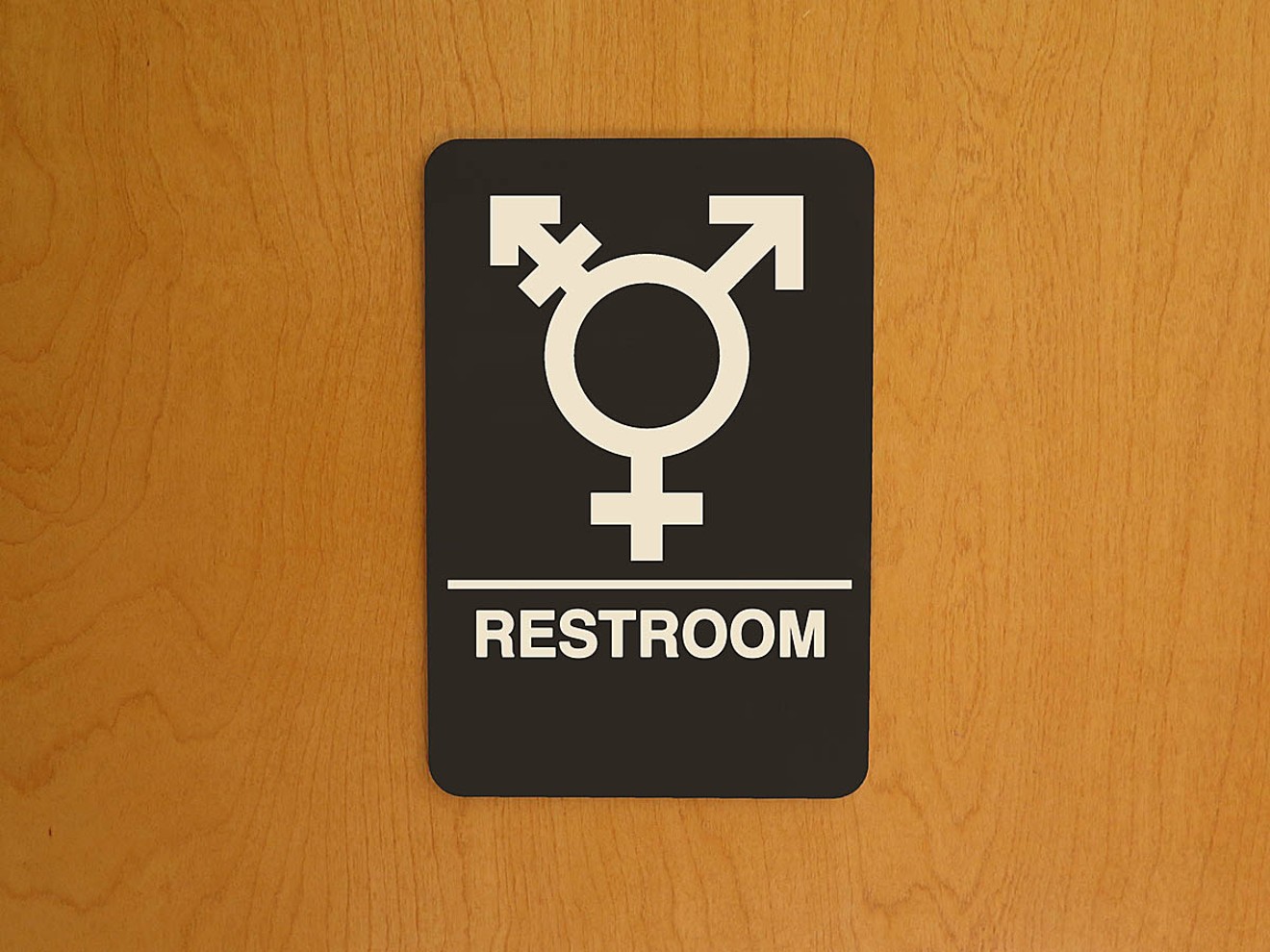When Robert Chevaleau’s daughter came out as transgender, it was adults, not the other kids, who had a hard time adjusting.
“The first day she went to school in a dress, she was ecstatic,” he recalls. “Her friends looked at her and said, ‘Why are you wearing a dress?’ She said, ‘I like the way it swirls.’ And then they ran off to play.”
But a few parents who he’d been in the habit of chatting with at drop-off gave him the cold shoulder. The casual morning conversations abruptly stopped.
Chevaleau is the president of AZTYPO, the Arizona Trans Youth and Parent Organization, which has roughly 100 members.
The organization and others like it around the country faced another major disappointment today — the second since Donald Trump was elected president —when the U.S. Supreme Court refused to hear a case over transgender student rights in Virginia.
Chevaleau, citing safety concerns, asked that Phoenix New Times withhold identifying details about his daughter, including her age and where she is enrolled in school.
His daughter is still young enough that she doesn’t think of herself as being different, he says. Nor does she know that her very existence is controversial.
“I don’t know when she’ll start to realize, and that’s a big source of stress for me as a parent,” he says.
Even for supportive and open-minded parents, having a transgender child can be scary. Transgender people face potential discrimination in just about every aspect of life — at school, at work, or while trying to find a place to live. They’re frequently the victims of hate crimes and homicides.
They also have a shockingly high attempted-suicide rate — 41 percent of transgender or gender nonconforming individuals have attempted suicide, compared to 4.6 percent of the general population.
“What parent would choose to sign their child up for discrimination and harassment?” points out Camellia Bellis, the director of the Transgender Education Program at Arizona State University's Sanford School. “Not that every trans person’s life is difficult, but based on the research and talking with parents, it is difficult for a lot of them.”
And then there’s the fact that transgender students have become something of a political football under the new administration.
So far, Trump has delivered on one campaign promise. He rolled back the Obama administration’s guidelines, which told schools that transgender students should be allowed to use the bathroom that matched with their gender identities, not with their biological sex.
“I wasn’t surprised, considering that President Trump was saying he was going to do this,” Chevaleau says. “It is a setback, but it’s not a setback 30 years. It’s a setback to April.”
Republicans argued that Obama had overstepped his authority when rolling out the guidelines, which Chevaleau can understand. But he disagrees with the White House’s claim that it’s a question of states’ rights.
“You can’t have a segment of your population that has rights in Oregon but not in Texas,” he points out. “The idea is that all people are created equal — not ‘All people are created equal, except in Michigan and Montana.’”
Another setback came today, when the Supreme Court announced that it wouldn’t hear arguments on the lawsuit filed by the ACLU on behalf of Gavin Grimm, a transgender high school student in Virginia. Grimm, 17, has been fighting for the right to use the boys’ bathroom at his school. The case is now back in appeals court, and the ACLU has announced that it will continue the fight.
Since the federal government isn’t issuing directives about how schools should support their transgender students, it’s up to individual districts to figure it out.
That’s where people like Camellia Bellis of ASU come in. Through the Transgender Education Project, she conducts workshops for teachers, administrators, nurses, counselors, and other educators.
Similarly, AZTYPO, which started seven years ago as a support group for the parents of transgender children and has doubled in size in the past year, has launched an initiative to reach out to schools and offer to conduct presentations about what transgender students need.
Offering a supportive school environment is literally lifesaving, Bellis says. When transgender students feel like they have the support of their parents and their school, their likelihood of committing suicide drops dramatically.
“If we can provide one little bubble that’s safe for them, at least they can look at that and say, 'At least I can be myself at school.'”
It’s not just a matter of referring to students by their preferred name and pronouns, although both those things are important. Schools need to be prepared to take action if a transgender student is being bullied, Chevaleau says.
They also need to expect resistance from other parents. And when kids ask uncomfortable questions, teachers shouldn’t just dismiss that curiosity. Instead, they should be ready with answers.
Also crucial: If schools have gender-specific dress code requirements, or divide kids up by gender, then transgender students should be allowed to follow the guidelines for the gender that they identify with. In other words, a transgender boy shouldn’t be forced into a skirt. And a transgender girl shouldn’t be forced to cut her hair short just because her birth certificate says “male.”
Bellis cautions educators against making the assumption that transgender kids are just going through a phase and will later change their minds.
“For most kids, they know between the ages of 3 to 5,” she says. “We’re talking about gender here, which is a very internal sense of yourself. And what we know from the medical community is that after six months, this is no longer considered a phase.
“We put it back on the person: ‘When did you decide your gender?’ Everyone’s like, ‘What do you mean, when did I decide my gender? I just always knew.’ And we say, well, that’s the same with trans kids.”
One issue that consistently comes up in workshops is what bathroom a transgender student should use.
Bellis makes sure to debunk the "bathroom predator" myth, which falsely claims that men are claiming to be transgender in order to sneak into women’s bathrooms. In reality, it’s transgender individuals who face the greatest risk when they go to the bathroom, whether it’s being beaten up, being yelled at, or in some cases even being expelled because they made the "wrong" choice.
But bathrooms shouldn’t be the main focus of the discussion, Bellis says.
“We really try and take the emphasis off of students’ body parts, because that’s what you’re talking about when you talk about bathrooms,” she points out. “You’re talking about a student's genitals, and that’s really inappropriate to talk about.”
Both Bellis and Chevaleau agree that by and large, schools want to do what’s in the best interest of their students.
“My experience has been that they want to help kids — that’s why they got into education — but they don’t know how,” Chevaleau says.
As a parent, too, his experience has been largely positive, he adds. “I can’t emphasize how big a relief that is — I can drop off my daughter for seven hours and know that she’s going to be supported, that teachers are looking out for bullying.”
Schools where he gives his presentation often warn him in advance, “We’re very conservative.” Chevaleau’s first response is, “I know. This is Arizona.”
But he also points out who you voted for doesn’t matter: People who consider themselves to be liberal can still be transphobic, and people who identify as conservative can still want transgender students to thrive.
“This isn’t a political issue, this is a civil rights issue,” he says.
[
{
"name": "Air - MediumRectangle - Inline Content - Mobile Display Size",
"component": "18478561",
"insertPoint": "2",
"requiredCountToDisplay": "2"
},{
"name": "Editor Picks",
"component": "16759093",
"insertPoint": "4",
"requiredCountToDisplay": "1"
},{
"name": "Inline Links",
"component": "17980324",
"insertPoint": "8th",
"startingPoint": 8,
"requiredCountToDisplay": "7",
"maxInsertions": 25
},{
"name": "Air - MediumRectangle - Combo - Inline Content",
"component": "16759092",
"insertPoint": "8th",
"startingPoint": 8,
"requiredCountToDisplay": "7",
"maxInsertions": 25
},{
"name": "Inline Links",
"component": "17980324",
"insertPoint": "8th",
"startingPoint": 12,
"requiredCountToDisplay": "11",
"maxInsertions": 24
},{
"name": "Air - Leaderboard Tower - Combo - Inline Content",
"component": "16759094",
"insertPoint": "8th",
"startingPoint": 12,
"requiredCountToDisplay": "11",
"maxInsertions": 24
}
]












